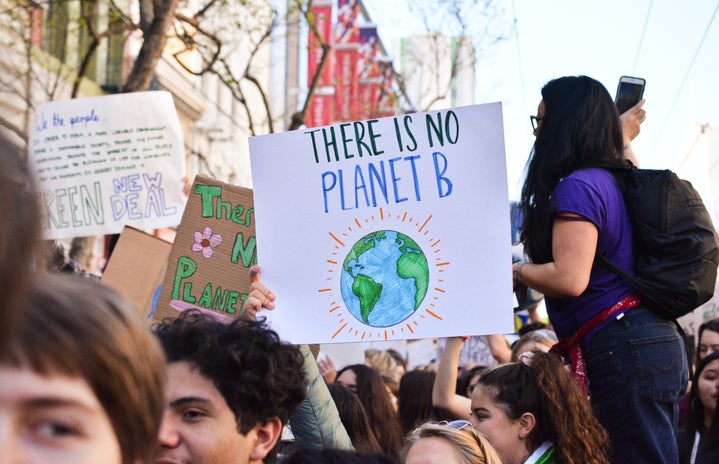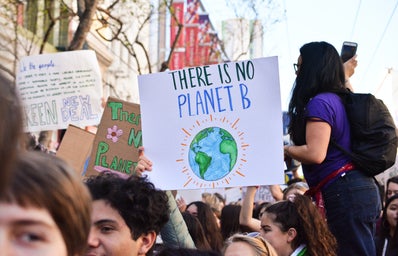“Stand up, fight back!”
Forests are disappearing.
“Stand up, fight back!”
Ice caps are melting.
“Stand up, fight back!”
Money is more important than our planet.
I still remember those four words ringing in my ears as the people around me shouted them with intensity and purpose. The first global climate strike took place on September 20, 2019 and all around the world, crowds gathered at the steps of city halls to try and desperately create change. I skipped school and went to the strike in Houston with my mom and that day has had such an impact on me, even now. It was raining very hard, yet there were still hundreds of people there, fighting for a cause much greater than I could’ve ever imagined. Hearing the speeches and seeing how passionate people were about saving our planet changed my perspective and was the start of my journey advocating for our planet.
What is climate change?
Climate change has taken on many different meanings in today’s society, each one catering towards a particular audience and spinning it to seem more “correct” in their eyes. Going off of its true definition, climate change is “a change in global or regional climate patterns, in particular a change apparent from the mid to late 20th century onwards and attributed largely to the increased levels of atmospheric carbon dioxide produced by the use of fossil fuels.”
You can read more about what exactly climate change is here.
What causes climate change?
The main factor going into our changing climate is the greenhouse effect, which according to NASA, is warming that results when the atmosphere traps heat radiating from the earth towards space. The burning of fossil fuels like coal and oil releases gasses and increases the atmospheric levels of carbon dioxide (CO2). As CO2 increases, it causes changes in weather patterns and essentially forces climate change.
The carbon cycle is the process that takes CO2 out of the air and basically recycles it through the process in order to maintain healthy levels of gasses in the atmosphere. I am not going to go into great detail about the processes in the cycle (we all took elementary biology), but if you want to learn more and see a visualization of the process, click here. So, what is happening is that we, as humans, are putting too much carbon dioxide into the atmosphere, and the natural processes can’t keep up, causing a shift in the gas levels. Carbon dioxide traps and radiates heat, so with the excess amount in our air, our climate changes and temperatures rise.
It isn’t just the burning of fossil fuels that puts CO2 into our atmosphere, though. Plastic that is thrown away goes to landfills and just sits, because plastic is not biodegradable. As these things sit, they emit carbon dioxide into the atmosphere. This, along with the creation of new plastic products in factories, contributes greatly to our atmospheric CO2 levels. Deforestation is also occurring in rainforests, and as you can imagine, the rainforests are vital in keeping CO2 levels stable. When large portions of the forests are cut and harvested, it throws off that balance, contributing to climate change.
Effects of climate change
During this century, the earth’s average temperature has increased by 2 degrees fahrenheit. This may not seem like a big jump, but let’s take the ice age as an example. The average temperatures near the end of the ice age were only 5 to 9 degrees cooler than today’s average. When put into perspective, a 2 degrees jump is pretty big.
Along with warmer temperatures (whether noticeable to us or not), comes the possibility of more droughts and heat waves, changes in rain patterns, stronger storms during storm season, and a rising sea level. These effects will only continue to get worse if changes aren’t made. All of these things have an even bigger impact than you may realize. With the rising temperatures and melting ice caps, lots of different animal species are being affected in many different ways, from their homes being destroyed to nesting sites not being capable of hosting life. So not only are we making our planet worse for humans, we are also affecting every other living being on this earth. Droughts and changing rain patterns affect crops, causing different growing patterns and even the inability for them to grow at all, sometimes. This is an issue because it will be harder to grow and harvest food in the future, leading to an increase in costs of produce and less food available overall.
What’s the big deal?
I know what you are thinking, this doesn’t affect me, there’s not going to be any big changes anytime soon, or maybe even that it isn’t real and it is just a ploy. As much as I wish it were the last one, sadly, climate change is very real and it affects each and every one of us.
On the NASA website, there is a diagram showing CO2 levels in our atmosphere over time, and it is a very steep uphill line. In January of 2005, the CO2 levels were at 378.37 ppm (parts per million, which is a way to measure carbon dioxide levels), and as of March of 2022, the levels are at 417.31 ppm. That is a huge jump, and it is all our fault. The burning of fossil fuels and nonrenewable sources of energy is what is causing this spike in CO2 levels, along with plastic that has been thrown away and just sits in landfills. As plastic sits, it emits amounts of carbon dioxide. This is why recycling is so important. But don’t worry, our actions are not the end all be all, things can still be helped.
It may not directly affect you, but it will affect all of the generations to come. There is only one livable planet, and if we destroy it, what do we have left? All of these climate changes seem minuscule, but when placed into perspective, they are huge! Everyone needs to come together to protect what has given us life, fed us, and housed us throughout the span of every human beings lifetime. That may sound dramatic, but think about how many resources we get from the earth: water, food, shelter. The planet can’t protect itself, so we need to do it.
What can you do?
The biggest and most important thing you can do is care. Once you care, it makes it one thousand times easier to adjust your lifestyle and to reduce your carbon footprint. Do research, look into the facts, and listen to people speak about climate change. Once you do this, open your mind and start caring. You have to be willing to help before you can actually help.
First, you can start by seeing exactly how much of an impact you are making, that way you have a tangible figure and can truly realize how much you, personally, are affecting our environment. This calculator on the EPA’s website asks a few questions about how much you spend on things like gas and propane, then it asks about your methods of transportation, then about the waste you produce. With each step, it also gives you the option to add a plan on how you can start reducing waste to lessen your carbon footprint. The report at the end gives you all the information you need to know how you are impacting the earth. I’ll be honest, mine wasn’t as great as I hoped it would be, but I was able to make a plan on how I can lessen my impact and I am working towards it everyday. You don’t realize how much of an impact you have until you see it in writing.
Some small things that can be done is simply switching over to more sustainable options in your day-to-day life. Switch paper towels in your kitchen for a few dish towels, switch plastic water bottles to a reusable one, use reusable grocery bags instead of the ones at the store. Simple things like this are easy ways to help reduce your carbon footprint without affecting your day to day life too much. Some more things you can do are unplug chargers and turn off lights when leaving your house, washing clothes with cold water, and carpooling when possible. You don’t have to drastically change your lifestyle to make a difference, just look into more sustainable options that are a bit better for the environment.
Lastly, get involved! A majority of the CO2 in our atmosphere is because big companies burn fossil fuels to run their factories and plants. The EPA has specific regulations in place, but it has been identified that 100 companies are responsible for 71% of all industrial emissions since human-driven climate change was recognized. That is absolutely insane! Somebody needs to hold these companies accountable, and although we don’t seem to have any say, we still have a voice. Donate to conservation funds, email political representative and tell anybody who will listen, volunteer, go to climate strikes, TAKE ACTION.
We only have one planet and it is time to stand up and fight back. This may not directly affect us, but it will affect our children and our children’s children and all the generations to come. There was a point in time where I wasn’t sure climate change was a real thing until I did my research and looked into it. After seeing the hard facts, I realized it is very real and we are the ones causing it. This is our home, why are we destroying it?


